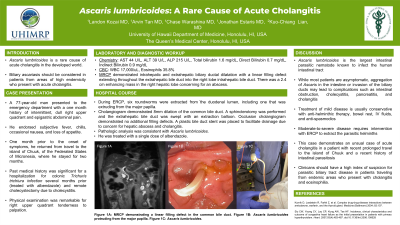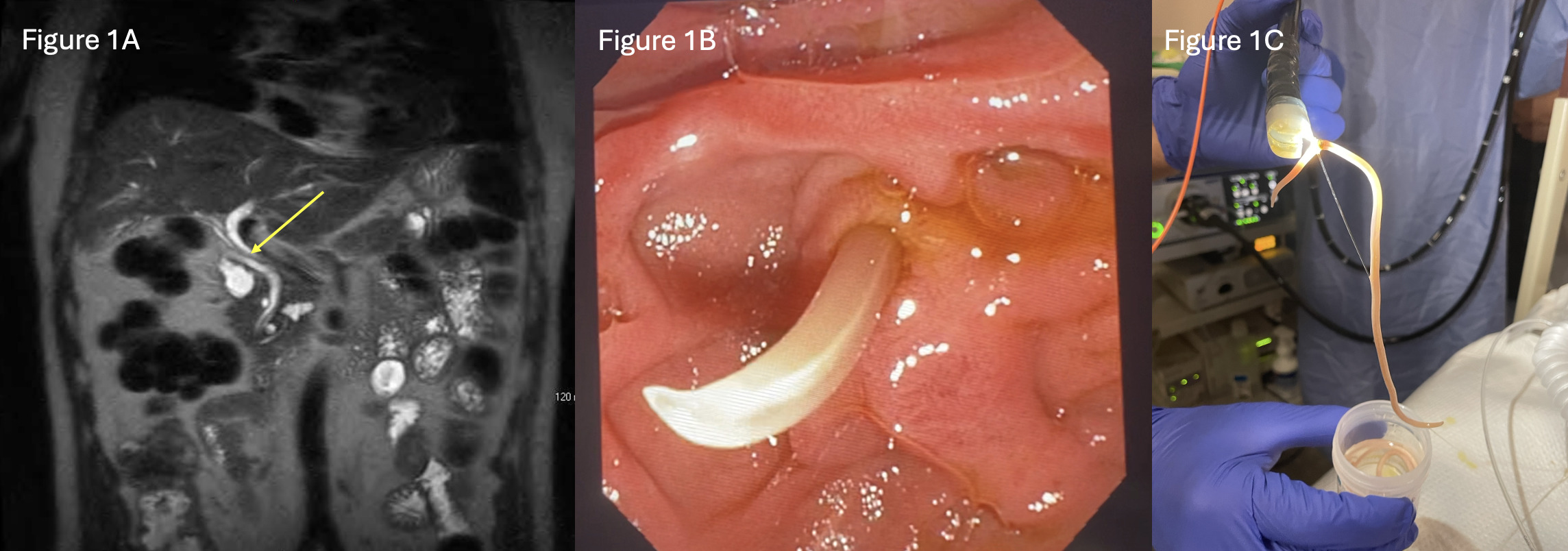Tuesday Poster Session
Category: Biliary/Pancreas
P3592 - Ascaris lumbricoides: A Rare Cause of Acute Cholangitis
Tuesday, October 29, 2024
10:30 AM - 4:00 PM ET
Location: Exhibit Hall E

Has Audio

Landon Kozai, MD
University of Hawaii, John A. Burns School of Medicine
Honolulu, HI
Presenting Author(s)
Landon Kozai, MD1, Arvin J. Tan, MD1, Chase Warashina, MD1, Jonathan Estaris, MD1, Kuo-Chiang Lian, MD2
1University of Hawaii, John A. Burns School of Medicine, Honolulu, HI; 2The Queen's Medical Center, Honolulu, HI
Introduction: Ascaris lumbricoides is a rare cause of acute cholangitis in the developed world. However, in patients from areas of high endemicity, biliary ascariasis should be considered. Here we describe a case of acute cholangitis due to biliary obstruction by Ascaris lumbricoides.
Case Description/Methods: A 77-year-old man presented to the emergency department with a one-month history of intermittent, dull right upper quadrant and epigastric abdominal pain. He endorsed subjective fever, chills, occasional nausea and loss of appetite. The patient had just returned from travel to the Island of Chuuk, Federated States of Micronesia, the month prior to the onset of symptoms. His medical history was notable for a recent hospitalization due to colonic Trichuris trichiura infection and a remote cholecystectomy. He had right upper quadrant tenderness on examination and labs were notable for a WBC of 17,000/uL, eosinophil count of 35.8%, total bilirubin 1.6 mg/dL, and alkaline phosphatase of 215 IU/L. MRCP demonstrated intrahepatic and extrahepatic biliary ductal dilatation with a linear filling defect extending throughout the extrahepatic bile duct into the right lobe intrahepatic bile duct. There was a 2.4 cm enhancing mass in the right hepatic lobe concerning for an abscess. During ERCP, six roundworms were extracted from the duodenal lumen, including one that was extruding from the major papilla. A sphincterotomy was performed, and a biliary stent was placed. Pathologic analysis was consistent with Ascaris lumbricoides. The patient was treated with anti-helminthics and antibiotics with subsequent clinical improvement.
Discussion: Ascaris lumbricoides is the largest intestinal parasitic nematode known to affect the human intestinal tract. While most patients are asymptomatic, aggregation of Ascaris in the intestine or invasion of the biliary ducts may lead to complications such as intestinal obstruction, cholecystitis, pancreatitis, and cholangitis. Treatment of mild disease is usually conservative with anti-helminthic therapy, bowel rest, IV fluids, and anti-spasmodics. Moderate-to-severe disease requires therapeutic intervention such as ERCP to extract the parasitic helminths. Clinicians should hold a high index of suspicion for parasitic biliary tract disease in patients traveling from endemic areas who present with cholangitis.

Disclosures:
Landon Kozai, MD1, Arvin J. Tan, MD1, Chase Warashina, MD1, Jonathan Estaris, MD1, Kuo-Chiang Lian, MD2. P3592 - Ascaris lumbricoides: A Rare Cause of Acute Cholangitis, ACG 2024 Annual Scientific Meeting Abstracts. Philadelphia, PA: American College of Gastroenterology.
1University of Hawaii, John A. Burns School of Medicine, Honolulu, HI; 2The Queen's Medical Center, Honolulu, HI
Introduction: Ascaris lumbricoides is a rare cause of acute cholangitis in the developed world. However, in patients from areas of high endemicity, biliary ascariasis should be considered. Here we describe a case of acute cholangitis due to biliary obstruction by Ascaris lumbricoides.
Case Description/Methods: A 77-year-old man presented to the emergency department with a one-month history of intermittent, dull right upper quadrant and epigastric abdominal pain. He endorsed subjective fever, chills, occasional nausea and loss of appetite. The patient had just returned from travel to the Island of Chuuk, Federated States of Micronesia, the month prior to the onset of symptoms. His medical history was notable for a recent hospitalization due to colonic Trichuris trichiura infection and a remote cholecystectomy. He had right upper quadrant tenderness on examination and labs were notable for a WBC of 17,000/uL, eosinophil count of 35.8%, total bilirubin 1.6 mg/dL, and alkaline phosphatase of 215 IU/L. MRCP demonstrated intrahepatic and extrahepatic biliary ductal dilatation with a linear filling defect extending throughout the extrahepatic bile duct into the right lobe intrahepatic bile duct. There was a 2.4 cm enhancing mass in the right hepatic lobe concerning for an abscess. During ERCP, six roundworms were extracted from the duodenal lumen, including one that was extruding from the major papilla. A sphincterotomy was performed, and a biliary stent was placed. Pathologic analysis was consistent with Ascaris lumbricoides. The patient was treated with anti-helminthics and antibiotics with subsequent clinical improvement.
Discussion: Ascaris lumbricoides is the largest intestinal parasitic nematode known to affect the human intestinal tract. While most patients are asymptomatic, aggregation of Ascaris in the intestine or invasion of the biliary ducts may lead to complications such as intestinal obstruction, cholecystitis, pancreatitis, and cholangitis. Treatment of mild disease is usually conservative with anti-helminthic therapy, bowel rest, IV fluids, and anti-spasmodics. Moderate-to-severe disease requires therapeutic intervention such as ERCP to extract the parasitic helminths. Clinicians should hold a high index of suspicion for parasitic biliary tract disease in patients traveling from endemic areas who present with cholangitis.

Figure: Figure 1A: MRCP demonstrating a linear filling defect in the common bile duct. Figure 1B: Ascaris lumbricoides protruding from the major papilla. Figure 1C: Ascaris lumbricoides
Disclosures:
Landon Kozai indicated no relevant financial relationships.
Arvin Tan indicated no relevant financial relationships.
Chase Warashina indicated no relevant financial relationships.
Jonathan Estaris indicated no relevant financial relationships.
Kuo-Chiang Lian indicated no relevant financial relationships.
Landon Kozai, MD1, Arvin J. Tan, MD1, Chase Warashina, MD1, Jonathan Estaris, MD1, Kuo-Chiang Lian, MD2. P3592 - Ascaris lumbricoides: A Rare Cause of Acute Cholangitis, ACG 2024 Annual Scientific Meeting Abstracts. Philadelphia, PA: American College of Gastroenterology.
